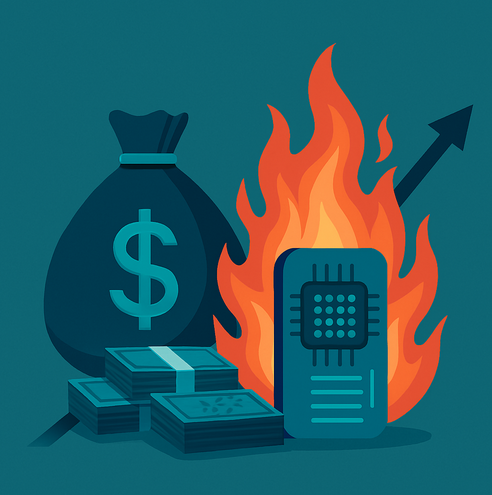OPENAI'S CASH BURN PARADOX
(NVDA), (MSFT), (GOOG),(AMZN)
You know what's crazy? A company that burns $5 billion a year in computing costs getting valued at $300 billion.
Yet here we are. OpenAI just closed a monster funding round, raising up to $40 billion from investors including SoftBank Group at a staggering $300 billion valuation. That's nearly double what the company was valued at just six months ago.
I've seen this movie before, both as a hedge fund manager and while dodging Russian artillery in Ukraine. Euphoria rarely ends well, whether in markets or on battlefields.
The company behind ChatGPT has become the darling of the investment world despite the fact that it won't be profitable until 2029, according to Sam Altman's own projections. 2029! That's four years and several AI generations from now.
This is a company that expects to generate $13 billion in revenue this year, which sounds impressive until you realize they'll likely spend more than that on computing costs alone. In fact, in 2024, OpenAI reported revenue of around $4 billion while racking up $5 billion in computing costs just to train and run their models.
When I was running hedge funds in the 1990s, we had a technical term for businesses like this: money pits.
Let's dive deeper into these numbers. Over 90% of OpenAI's 500 million users worldwide pay absolutely nothing to use the service. In 2025, the company projects that just under 5% of users might pay the $20-a-month charge to access their more advanced AI models. That would generate about $5.5 billion. Another 0.3% might opt for ChatGPT Pro, contributing another $3.6 billion.
The trouble is that a whopping 70% of OpenAI's revenue comes with expenses that may keep rising faster than the top line. According to reporting from The Information, by the end of the decade, OpenAI will still probably spend 60% to 80% of its annual revenue just to train or run its models.
Meanwhile, competition is heating up. OpenAI's market share of enterprise large language models (LLMs) has already fallen to 34% in 2024 from 50% a year ago, according to Menlo Ventures data. Companies like Anthropic, Meta, Google, and Mistral AI are eating into their lead.
And there's another problem: intense pricing competition. As companies like Mistral AI and Anthropic offer competitive alternatives, OpenAI's ability to charge premium prices for its API services is under pressure.
During my decades reporting from Asia, I witnessed countless companies with "revolutionary technology" that eventually became commoditized faster than anyone expected. When I covered the Japanese semiconductor industry in the 1970s, companies that once had seemingly unassailable leads saw their margins evaporate within years.
So why are investors like SoftBank's Masayoshi Son so eager to pour billions into this cash-burning machine? The answer lies in the potential of achieving artificial general intelligence (AGI) – AI systems that can perform any intellectual task that a human can. If OpenAI succeeds in developing AGI, the economic rewards could be incalculable.
In a fascinating twist, OpenAI just made its first cybersecurity investment, putting money into a startup called Cosmic. This signals a strategic expansion beyond its core AI development work. Smart move, considering that as AI becomes more ubiquitous, securing it becomes increasingly critical.
Additionally, there are rumors that OpenAI may release an open-source model, which would be a significant shift in strategy. This could be a play to expand their ecosystem and solidify their position as the standard-bearer in AI development.
For investors trying to play the AI revolution, the question becomes: is it better to invest directly in pure AI plays like OpenAI (if and when it goes public), or in the companies that actually make money from the AI boom today?
The smartest money might be in NVIDIA (NVDA), which supplies the crucial GPUs that power AI development. Despite trading at seemingly high multiples, NVIDIA continues to see explosive growth in data center revenue as AI development accelerates. Even with competition from AMD and Intel, NVIDIA maintains a commanding lead in AI chip technology.
Microsoft (MSFT) provides another interesting angle, given its deep partnership with OpenAI. The company has exclusive rights to commercialize OpenAI's technology and has already integrated ChatGPT capabilities across its product line, from Bing to Office 365.
For those looking at pure AI plays beyond the giants, Anthropic (backed by Google (GOOG) and Amazon (AMZN)) and Mistral AI represent interesting alternatives to OpenAI, though they remain private for now.
Is AI revolutionary? Absolutely. Are most AI companies going to make money anytime soon? Don't bet your retirement on it. For OpenAI to hit Altman's projected $125 billion revenue target by 2029, they need to grow 10-fold while dramatically shifting from money-losing free users to enterprise clients that actually pay the bills.
That's a tall order, even for a company with seemingly unlimited access to capital. I've witnessed too many "guaranteed successes" implode over my five decades in the markets. After covering countless bubbles from Tokyo to Silicon Valley, I've learned that eventually, cash flow matters. Always.
If I were allocating capital today, I'd be putting my money on companies with proven ability to convert AI hype into actual profits. Let others chase the AGI dream while you count real returns.
At this late stage in my life, I've learned that what seems inevitable rarely is, and what looks impossible often becomes routine within years. Will OpenAI justify its $300 billion valuation? Perhaps. But at these prices, investors are paying for perfection when the company hasn't even figured out a sustainable business model.
That's not investing – that's speculation.
And if there's one thing my bullet wound from Ukraine taught me, it's that life's too short for bad bets.


